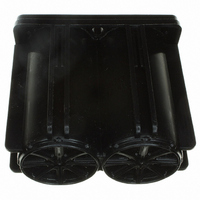0819-0010 EnerSys, 0819-0010 Datasheet - Page 14

0819-0010
Manufacturer Part Number
0819-0010
Description
BATT CYCLON SLA 4V 2.5AH
Manufacturer
EnerSys
Series
Cyclon®r
Type
Sealed Lead Acid Batteriesr
Specifications of 0819-0010
Voltage - Rated
4V
Capacity
2.5Ah
Size / Dimension
3.13" Dia x 1.81" H (79.5mm x 46.0mm)
Termination Style
Spade, .187" (4.7mm)
Rechargeability
Yes
Weight
0.05 lb (22.68g)
Output Voltage
4 V
Chemistry
Lead Acid
Rechargeable/non-rechargeable
Rechargeable
Battery Capacity
25 Ah
Lead Free Status / RoHS Status
Lead free by exemption / RoHS compliant by exemption
Other names
842-1006
14
6.8 Constant Current (CC) Charging
Constant current (CC) charging is another efficient method
of charging CYCLON
CC charging of a cell or battery is accomplished by the
application of a nonvarying current source. This charge
method is especially effective when several cells are
charged in series since it tends to eliminate any charge
imbalance in a battery. CC charging charges all cells in the
battery.
Figure 6-2: Constant Current Charging at 0°C
Figure 6-3: Constant Current Charging at 25°C
Figure 6-4: Constant Current Charging at 45°C
www.enersys.com
2.8
2.6
2.4
2.2
1.8
2.8
2.6
2.4
2.2
1.8
2.8
2.6
2.4
2.2
1.8
3
2
2
3
2
0
0
0
C/5
5
5
5
C/5
C/5
Constant Current Charging
®
Voltage Profiles at 25°C
Constant Current Charging
Voltage Profiles at 45°C
Constant Current Charging
Voltage Profiles at 0°C
10
10
battery single cells and monoblocs.
10
Time (Hours)
Time (Hours)
Time (Hours)
C/10
C/10
C/10
15
15
15
C/15
C/15
C/15
20
20
20
C/20
25
25
C/20
C/20
25
30
30
30
Figure 6-2 is a family of curves depicting cell voltage
vs. time at different CC charging rates at an ambient
temperature of 0°C (32°F). Figures 6-3 and 6-4 show the
same curves bit at two different temperatures - 25°C (77°F)
and 45°C (113°F), respectively. Table 6-4 summarizes these
three graphs.
Table 6-4
Peak Voltage,
volts per cell
Time to reach
peak voltage,
hours
As shown by these curves, the voltage of the cell rises
sharply as the full charge state is approached. This increase
in voltage is caused by the plates going into overcharge
when the majority of the active material on the plates has
been converted from lead sulfate to spongy lead on the
negative plate and lead dioxide on the positive plate.
The voltage increase will occur at lower states of charge
when the cell is being charged at higher rates. This is
because at the higher CC charge rates, the charging
efficiency is reduced. The voltage curves in Figures 6-2
to 6-4 are different from those of a conventional lead-acid
cell due to the effect of the recombination of gases on
overcharge within the pure lead-tin system.
While CC charging is an efficient method of charging,
it requires a greater degree of control to prevent serious
overcharge. Continued application at rates above C
after the cell is fully charged, will be detrimental to the life
of the cell.
At overnight charge rates (C
increase in voltage at the nearly fully-charged state is a
useful indicator for terminating or reducing the rates for a
CC charger. If the rate is reduced to between C
C
yield a float life up to 8 to 10 years at room temperature
(25°C/77°F).
These graphs and charts reflect data obtained from
CYCLON cells that had been cycled three times at the
C
as specification values but rather as guidelines to follow
when developing or using a CC charger.
10
10
Parameter
/500, the cell can be left connected continuously and
/5 rate. Thus, these numbers should not be treated
45°C (113°F) 2.78
45°C (113°F) 2.78
25°C (77°F) 2.83
25°C (77°F) 2.83
Temperature
0°C (32°F)
0°C (32°F)
Publication No: US-CYC-AM-007 - April 2008
10
/10 to C
2.91
2.91
C/5
10
2.87
2.79
2.71
2.87
2.79
2.71
C/10
/20), the large
2.84
2.76
2.67
2.84
2.76
2.67
C/15
10
/1000 and
10
/500,
2.82
2.73
2.64
2.82
2.73
2.64
C/20















